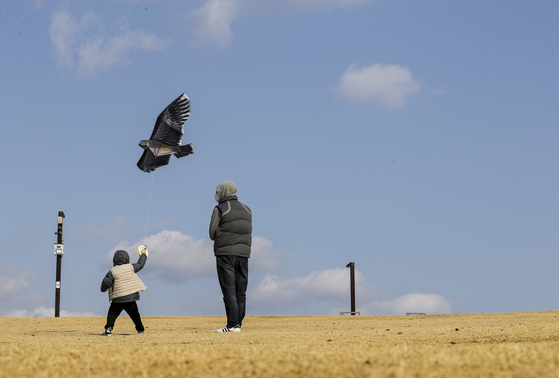
On the afternoon of the afternoon of the 21st, a father and son fly a kite at Pyeonghwanuri Park in Imjingak, Paju, Gyeonggi-do. On this day, a strong wind warning was issued in regions such as the west coast and the mountainous areas of Gangwon, and a gust of wind blew nationwide. Reporter Kim Gyeong-rok / 2021.03.21
As the north wind blows strongly, the air quality across the country on the 22nd once showed a level of’good’. However, from the night of the 22nd, the concentration of fine dust is expected to rise again due to the yellow dust.
According to the Meteorological Administration on that day, strong winds of 20 to 35 km/h are blown across the country during the day on the 22nd. Stronger winds are expected from the 23rd to the 24th morning.
Reporter Park Jeong-min of the Meteorological Administration said, “As the air pressure difference between the low pressure in the east and the high pressure in the west is large, the wind will blow a little at 5 to 10 meters per second during the 22nd daytime.” It should be noted that a gust of about 20m per second may occur.”
The dust accumulated over the past week was scattered by strong winds, and the concentration of ultrafine dust (PM2.5) nationwide on the 22nd showed a level of’Good’ to’Normal’, not exceeding the daily average of 20㎍/㎥ as of 1:00 PM. The concentration of fine dust (PM10), which had been high for a while due to the yellow dust, was also less than 40㎍/㎥ on average per day, showing a generally’normal’ level across the country.
Yellow dust on the night of the 22nd, inflow of ultrafine dust in the morning of the 23rd

The Forbidden City in Beijing, China hit by a sand storm on the 15th. EPA=Yonhap News
However, from the evening of the 22nd, the air quality is expected to deteriorate again. According to the National Institute of Environmental Sciences’ Integrated Fine Dust Forecast Center, yellow dust originating from Mongolia’s Gobi Desert and China’s Inner Mongolia Highlands on the 21st affects the air quality of the Korean Peninsula, centering on the west coast from the night of the 22nd.
An official from the forecast center said, “From late on the 22nd to the dawn on the 23rd, yellow dust will enter over the metropolitan area and the Chungcheong area, and from the 23rd, as the southwest wind blows, some ultrafine dust is expected to flow in in the morning.” It is expected that the level of’bad’ in the metropolitan area and Chungcheong area is expected by the morning of the 23rd, and it is generally resolved in the afternoon of the 23rd as the wind blows a lot thereafter, and it is expected that the southern part of Gyeonggi and some of the Chungnam areas will show a level of’bad’.

On the morning of the 22nd, when the whole country showed a morning temperature of around 0 degrees Celsius, Sanggodae appears white in bloom at Cheonwangbong Peak in Mt. Jirisan. News 1
In addition to the influence of the wind from the north, the land cools overnight in clear weather, and the morning of the 23rd, the temperature is about 2-5 degrees below zero in Seoul, 1 degrees below zero in Chuncheon, 1 degrees in Daegu, and 2 degrees in Gwangju. Stop.
However, as warm air flows in from the southwest, the highest temperature during the day will rise to around 15 degrees in most regions of the country, including Seoul and Busan 17 degrees, and Daegu and Pohang 19 degrees, and near 20 degrees in Gyeongsang inland and the east coast. . The large daily temperature difference around 15 degrees lasts until the 24th.
Reporter Kim Jeongyeon [email protected]
![]()
